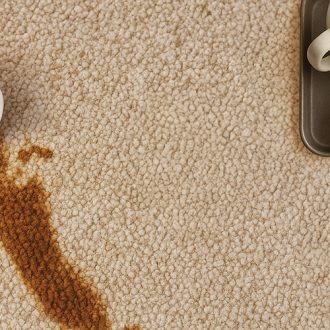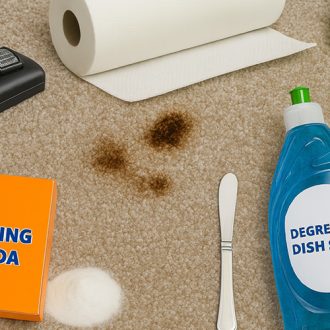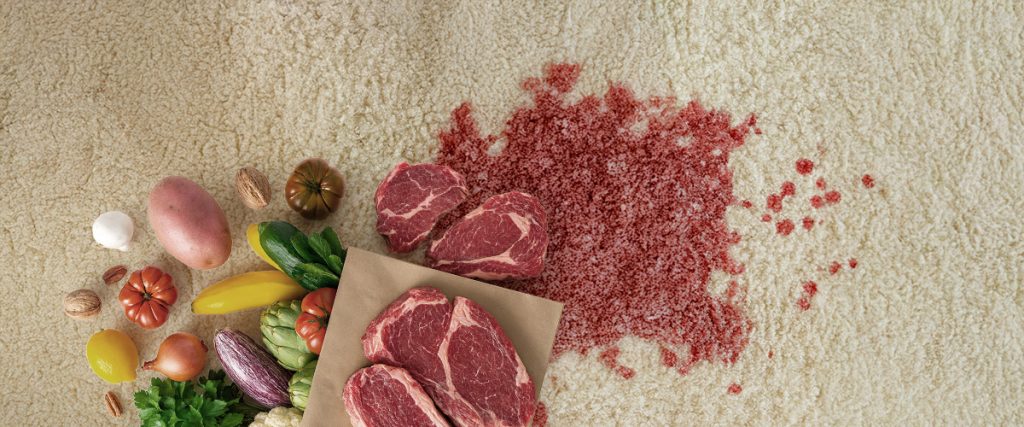
Blood stains on carpet can be overwhelming, especially if you have beautiful light carpet. Whether it’s a small cut, a pet accident, or an unexpected spill, those dark marks seem to set in fast. Now, if you add in Florida’s high humidity, stains can become even more stubborn, with odors or discoloration showing up if not handled quickly.
The good news is that with the right steps, you can often remove blood stains at home. Acting fast and using simple cleaning methods can save your carpet and keep your home looking fresh. For tougher stains, Mint Condition’s certified technicians in Orlando and Central Florida are always ready to help with professional carpet cleaning.
Why Blood Stains Are Hard to Clean from Carpet
Ok, let’s agree that blood stains aren’t like simple dirt or mud. They’re made up of proteins, iron, and other compounds that naturally cling to fibers. Once the stain sets, it bonds tightly with carpet materials. Let’s take a look at the main reasons why blood can be so difficult to lift.
Protein Binding
Blood contains proteins that act like glue. When they touch carpet fibers, they latch on and form strong bonds. The longer the stain sits, the more those proteins harden and dig in.
Oxidation
When blood is exposed to air, it oxidizes and darkens. That’s why older blood stains change color as time goes by. They start out bright red, and after a few days, they turn brown or rusty. This chemical change makes them harder to clean than fresh stains.
Coagulation
Blood naturally clots and thickens as it dries. That’s a great property when you cut yourself, because who wants to bleed to death? But on a carpet, coagulation is the enemy. Why? Because as it thickens, the stain doesn’t just stay on the surface; it pushes deeper into the fibers, creating layers that are tough to remove. Yuck!
Fiber Complexity
Different carpet types react differently. For example, plush carpets absorb more quickly, and looped or patterned fibers they can trap particles in tight spots. Florida homes have a wide mix of carpet styles, and synthetic blends in particular can hang on to stains more stubbornly than natural fibers.
| Carpet Fiber Type | Stain Removal Difficulty | Why It’s Hard / Delicate |
|---|---|---|
| Nylon | Moderate | Strong synthetic fiber, resists wear but absorbs stains if not treated quickly. |
| Polyester | Moderate to Hard | Resists moisture but attracts oily stains, which makes blood cling longer. |
| Olefin (Polypropylene) | Hard | Naturally water-resistant, but blood can sit on top and then harden into fibers. |
| Wool | Delicate | Natural fiber, very absorbent and sensitive to harsh cleaners. |
| Triexta (SmartStrand) | Easy to Moderate | Stain-resistant fiber, but blood still needs quick attention. |
| Blended Carpets | Varies | Mix of fibers means mixed results; some areas stain faster than others. |
✅ Mint Condition insight: In Central Florida, we often see polyester and nylon carpets in family homes. They’re durable but can hold onto blood if not treated right away. Wool is the trickiest, beautiful, but one wrong cleaner can damage it permanently.
How to Get Blood Out of Carpet
⚠️Disclaimer: Use these cleaning methods at your own risk. Carpet materials vary and may react differently to certain products, which could cause damage or discoloration. Always test on a hidden area first. For delicate, valuable, or heavily stained carpets, it’s best to contact a certified professional.
Now let’s walk through the actual cleaning steps. Keep it simple, stay patient, and don’t rush the process.
Important: do not use hot water on fresh blood stains! It will set the blood stain, making it harder to remove.
Hot water causes proteins in blood to “cook” and bind permanently to fibers. Stick with cold water only.
Step 1: Gently Blot, Don’t Rub
Grab a clean white cloth or paper towel. Press down to absorb the stain, but never rub. Rubbing spreads the blood and pushes it deeper.
Step 2: Lightly Rinse with Cold Water
Dampen the area with cold water. This helps dilute the stain and keeps it from setting further.
Step 3: Clean with Dish Soap and Cold Water Mixture
Mix a few drops of mild dish soap with cold water. Dab the mixture onto the stain with a cloth or sponge. Dish soap helps break down the proteins without harming the carpet.
Step 4: Blot and Repeat if Needed
Blood stains rarely disappear in one pass. Keep blotting and applying the soapy mixture until the stain lightens. Patience pays off here.
Step 5: Air Dry and Vacuum
Once the stain is gone, let the carpet air dry completely. Then vacuum to lift the fibers and restore the texture.
Summary: How to Get Blood Out of Carpet
| Step | Material / Tool | Purpose |
|---|---|---|
| Blot stain | White cloth or paper towels | Absorb excess blood without spreading |
| Rinse area | Cold water | Dilutes stain and prevents setting |
| Apply cleaner | Dish soap + cold water | Breaks down proteins in blood |
| Repeat | Clean cloth | Lightens stain gradually |
| Finish | Vacuum | Restores carpet texture after drying |
If you follow the steps and the blood stain is gone, congratulations! You are done. If the stain is not gone, it’s OK below are some extra steps you can take.
Tried everything, and the blood carpet stains are still there? Let the pros at Mint Condition handle it.
Mint Condition offers professional, fast, and effective carpet cleaning across Orlando and Central Florida. Book your service now by filling out a contact form or calling (407) 456-2035.
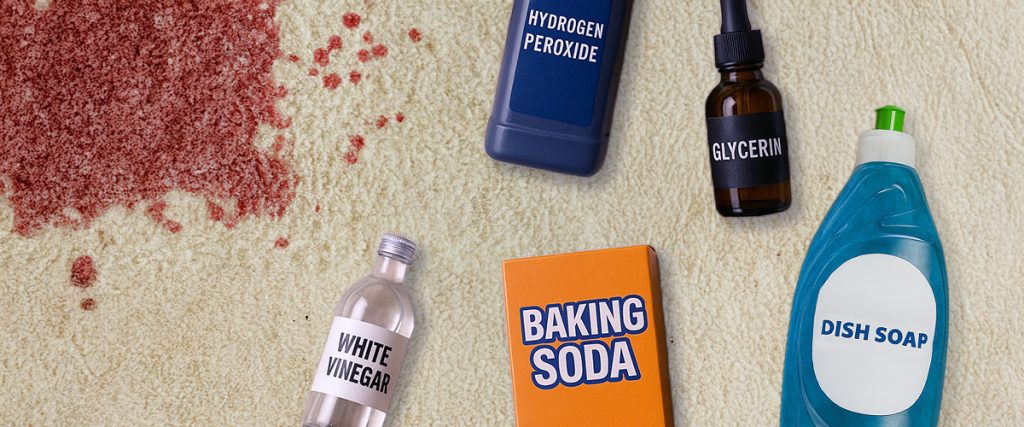
Troubleshooting Tough Blood Stains
Sometimes the simple steps aren’t enough, especially if the stain has been sitting for a while. In that case, you’ll need to try a few extra tricks. These methods use common household items, but remember: always test on a small hidden area first. Carpets react differently, and you don’t want to create discoloration while trying to fix the stain.
Natural Absorbents: Salt, Cornstarch, or Baking Soda
Sprinkle one of these over the dampened stain and let it sit. They work by drawing blood up from the fibers. After 15–30 minutes, vacuum up the powder and check the results.
White Vinegar for Mild Stains
Mix one part white vinegar with two parts cold water. Dab onto the stain, blot gently, and repeat if needed. Vinegar helps loosen dried blood, but don’t soak the carpet; light applications work best.
Hydrogen Peroxide on Light-Colored Carpets Only
Hydrogen peroxide can be effective, but it’s a bleaching agent, so it should only be used on white or very light-colored carpets. Apply a small amount, let it fizz, then blot with a clean cloth.
Does Hydrogen Peroxide Remove Blood Stains?
Yes, it can break down the proteins in blood, making it easier to blot away.
Does Hydrogen Peroxide Stain Carpet?
It might. On darker carpets, peroxide can lighten the fibers permanently. That’s why Mint Condition only recommends this method for white or off-white carpets.
Meat Tenderizer Trick for Protein-Based Stains
Mix meat tenderizer with a little water to create a paste. Spread it over the stain and let it sit for about 30 minutes before blotting with cold water. Since blood is protein-based, the enzymes in meat tenderizer help break it down.
Club Soda for Quick Fresh Blood Removal
Club soda works because of its carbonation. Those little bubbles are made of carbon dioxide, and when they fizz, they create a gentle lifting action that can help loosen particles from carpet fibers. Think of it like tiny scrubbing bubbles, helping you clean without the rubbing. Club soda is also a more environmentally friendly option, safer for pets and kids, because it doesn’t contain harsh chemicals.
To use it, pour a small amount of club soda directly onto the fresh blood stain. Let the bubbles fizz for a few seconds, then blot gently with a clean cloth. The fizzing action helps break the bond between the blood and the carpet, making it easier to lift.
Keep in mind that Club soda is not a miracle solution for dried stains, but for a fresh spill, it can be a quick helper before moving on to other cleaning methods.
Glycerin and Detergent Spray for Older Stains
Mix equal parts glycerin, dish detergent, and cold water in a spray bottle. Spray lightly, let it sit for 10–15 minutes, and blot. This is especially helpful for stains that have been there for weeks.
Will Dawn Remove Blood from Carpet?
Yes, Dawn or another mild dish soap can break down proteins in blood.
If you are wondering why dish soap is better than regular soap, it’s because dish soap is made to cut through grease and proteins gently, without leaving behind a heavy residue.
Bar soaps or body soap, on the other hand, often contain moisturizers, oils, or perfumes that can actually make a stain worse or leave a film on the carpet fibers.
Dish soap mixes easily with cold water, creates a light solution, and rinses out clean. That’s why our technicians recommend it for treating blood stains and other organic messes.
✅ Mint Condition tip: We often recommend a few drops of clear, unscented dish soap in Orlando homes for safe stain removal. Skip the fancy soaps with additives; simple works best.
Does WD-40 Remove Blood Stains?
Yes, WD-40 can be effective at removing fresh blood stains because its properties help to loosen and dissolve the blood. If you decide to try it, please always follow WD-40’s official instructions and test on a hidden area first to rule out discoloration or new stains. For best results, treat the blood stain while it is still fresh and always use cold water.
Troubleshooting Blood Stains: Quick Reference Table
| Method | Best For | How It Works | Risk / Limitation |
|---|---|---|---|
| Salt, Cornstarch, Baking Soda | Fresh or lightly dried stains | Absorb moisture and pull blood out of fibers | May need repeat applications |
| White Vinegar | Mild dried stains | Breaks down residue and light discoloration | Strong smell, avoid soaking carpet |
| Hydrogen Peroxide | Light-colored carpets only | Fizzes to lift proteins from fibers | Can bleach darker fibers |
| Meat Tenderizer Paste | Older, protein-based stains | Enzymes break down blood proteins | Unusual method, mixed results |
| Club Soda | Quick fresh stains | Carbonation helps loosen the stain | Limited effectiveness on dried stains |
| Glycerin + Detergent Spray | Older, stubborn stains | Softens dried residue, detergent lifts it | Requires patience, multiple tries |
| Dawn Dish Soap | General use, most carpets | Gently breaks down proteins and rinses clean | Must use cold water, avoid oversoaking |
| WD-40 | Fresh stains on some fabrics | Loosens residue, lifts stain | Oily, not ideal for carpet, risk of discoloration |
How to Remove Blood Stains from Carpet
Dried stains need more patience because the blood has already oxidized and bonded to fibers.
- Start by softening the stain and dampen it with a small amount of cold water.
- Sprinkle baking soda or cornstarch over the spot and let it sit for 30 minutes.
- Vacuum, then dab with a dish soap and cold water mix.
If the stain doesn’t lighten after two tries, it’s time to call a professional to avoid fiber damage.
Fresh stains are easier to treat if you act quickly before the proteins set.
- Blot the stain right away with a clean white cloth or paper towel.
- Lightly rinse with cold water, never hot, to keep the blood from bonding to fibers.
- Apply a mix of dish soap and cold water to the spot and blot again.
- Repeat until the stain fades, then let the carpet air dry completely.
If the stain doesn’t lift after a couple of rounds, professional cleaning may be the best solution.
Animal blood behaves the same as human blood, but it can leave behind stronger odors.
- Blot as much of the stain as you can with a clean cloth.
- Rinse with a little cold water, then apply a dish soap and cold water solution.
- If odor remains, sprinkle baking soda, let it sit for 15 minutes, then vacuum.
For large or repeated stains, call a professional to prevent deep odors from returning.
White carpets are delicate and show stains quickly, so caution is key.
- Blot the stain gently with cold water first.
- Apply a small amount of hydrogen peroxide only if the carpet is white or very light.
- Let it fizz for a few seconds, then blot with a clean cloth.
- Always test hydrogen peroxide in a hidden corner before using it on the main stain.
If the stain lingers, a certified technician can safely remove it without risking discoloration.
Large stains can soak deep into both the carpet fibers and the pad underneath.
- Blot the surface stain with a cloth to remove as much as possible.
- Work in smaller sections using cold water and dish soap to prevent oversaturation.
- Avoid flooding the carpet, since liquid can push the stain into the padding.
If the stain covers more than a few inches, professional carpet extraction is the safest option.
Sometimes you need results quickly, especially if guests are on the way or the spill just happened.
- Grab a clean white cloth and blot up as much as you can immediately.
- Pour a small amount of cold water on the area and blot again to dilute the stain.
- Mix a few drops of dish soap in cold water, apply lightly, and keep blotting until the stain fades.
- Air dry the spot and vacuum to restore the carpet’s texture.
- Acting in the first few minutes is the best way to keep the stain from setting permanently.
Fake blood, often used in costumes or theater makeup, can contain dyes that behave differently than real blood.
- Start by blotting up as much as possible with a paper towel.
- Rinse with cold water to reduce the dye’s intensity.
- Apply a dish soap and cold water mix, then blot until the color starts to fade.
- If the fake blood has strong dyes (like from Halloween makeup), use a vinegar and water mix to help break it down.
Since dyes can permanently tint carpet fibers, professional cleaning is the safest choice if the stain doesn’t budge.
Hydrogen peroxide can be powerful, but it must be used carefully.
- Blot the stain with cold water first to remove as much as possible.
- Apply a small amount of hydrogen peroxide directly to the stain if your carpet is white or very light-colored.
- Let it fizz for 30–60 seconds, then blot with a clean white cloth.
- Repeat once if needed, but avoid overusing since peroxide can weaken carpet fibers.
If your carpet is dark, skip peroxide entirely and choose a safer method.
Salt is a natural absorbent that can help draw out blood.
- Dampen the stain with cold water.
- Sprinkle salt generously over the area and let it sit for 10–15 minutes.
- Blot and vacuum up the residue, then repeat if needed.
Salt works best for small, fresh stains but isn’t as effective for older, dried spots.
Vinegar is mildly acidic and can help loosen dried blood.
- Mix one part white vinegar with two parts cold water.
- Dab the solution onto the stain and blot with a cloth.
- Rinse lightly with cold water to remove the vinegar smell.
Vinegar is safer than many chemicals, but avoid over-soaking to protect the carpet pad.
The best cleaner depends on the situation:
- For fresh stains, cold water and dish soap are simple and effective.
- For dried stains, try baking soda or cornstarch to absorb residue before using dish soap.
- For light carpets, hydrogen peroxide may help, but test carefully.
- For large or deep stains, professional carpet cleaning is the most reliable solution.
No single cleaner works for all stains, but using the right method for the right situation makes the difference.
Don’t let a blood stain linger in your carpet.
For Orlando homeowners, quick action can make the difference between a clean carpet and a permanent stain. When in doubt, our eco-friendly cleaning methods restore carpets safely and effectively across Central Florida. Call (407) 456-2035 or fill out a contact form to schedule your expert carpet cleaning today.
Blood Stain Removal Methods Summary
| Method | Best Use Case | Key Advantage | Limitation / Caution |
|---|---|---|---|
| Cold Water + Dish Soap | Fresh stains, most carpet types | Safe, simple, and effective for small spots | Requires patience and blotting, not great for dried stains |
| Hydrogen Peroxide | White or very light-colored carpets | Breaks down proteins quickly, visible fizz | Can bleach or discolor darker carpets |
| Salt | Small, fresh stains | Natural absorbent, easy to use | Less effective on old or large stains |
| Vinegar Solution | Mild dried stains | Loosens residue, eco-friendly | Strong smell, avoid over-soaking |
| Baking Soda / Cornstarch | Fresh or slightly dried stains | Pulls moisture and residue out of fibers | Needs vacuuming and sometimes repeats |
| Club Soda | Very fresh stains | Carbonation helps lift particles | Minimal effect on dried stains |
| Fake Blood Cleanup (Vinegar or Dish Soap) | Costume or dye-based stains | Breaks down artificial coloring | Dyes may permanently tint fibers |
| Professional Cleaning | Large, old, or deep stains | Safest and most thorough option | Needed if DIY doesn’t succeed |
Common Mistakes to Avoid When Treating Blood Stains
When it comes to blood stains, the wrong move can make things worse. Here are some of the most common mistakes we see Central Florida homeowners make:
- Using Hot Water: Hot water sets the proteins in blood permanently into the fibers. Always use cold water.
- Rubbing Instead of Blotting: Rubbing spreads the stain and pushes it deeper. Blot gently instead.
- Over-Soaking the Carpet: Too much liquid can soak through the carpet pad, causing bigger stains and even odors later.
- Skipping a Test Spot: Every carpet reacts differently. Always test cleaners in a hidden spot first.
- Using the Wrong Cleaner: Harsh chemicals or bleach can discolor fibers and damage the carpet permanently.
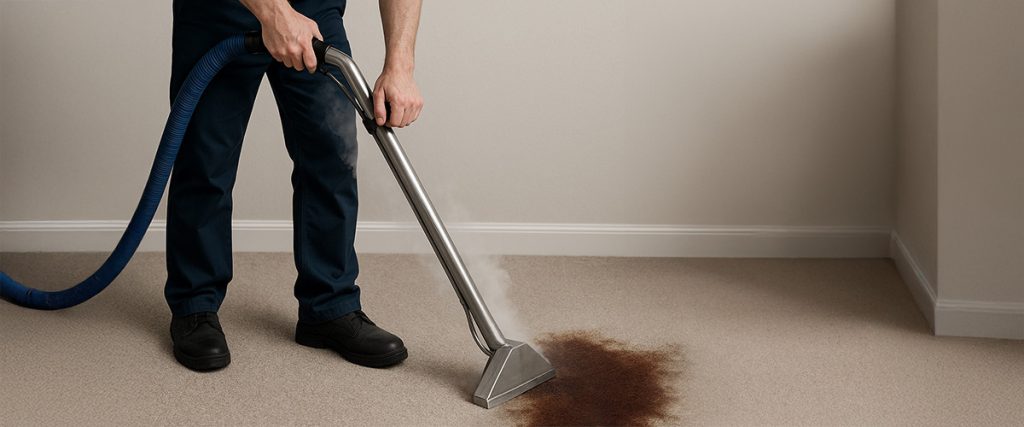
When Should I Call an Orlando Carpet Cleaning Company to Professionally Get Blood Stains Out of Carpet?
Not every stain needs professional help, but sometimes it’s the smartest move. Here’s when you should consider calling in the pros:
- Large or Spread-Out Stains: If the stain covers more than a few inches, DIY methods may not cut it.
- Dried or Old Stains: Older blood is tough to remove without professional equipment.
- Delicate or Expensive Carpets: Wool and other natural fibers can be permanently damaged by the wrong cleaner.
- Persistent Odors: If you notice a smell that won’t go away, the blood may have soaked into the pad underneath.
- Multiple Failed Attempts: The more you scrub with the wrong cleaner, the harder the stain becomes to remove later.
At Mint Condition, our IICRC-certified technicians use eco-friendly methods that are safe for pets and kids, while delivering a deeper clean. We serve homeowners throughout Orlando, Altamonte Springs, Oviedo, Winter Park, and more, with same-day service available in many cases.
Conclusion
Blood stains can be intimidating, especially on light, expensive, or delicate carpets, but they don’t have to be permanent. The key is acting quickly, using cold water, and choosing the right method for the situation. Whether it’s a small pet accident, a cut, or even fake blood from a costume, there’s usually a safe way to treat it at home.
At Mint Condition, we’ve helped homeowners across Orlando and Central Florida restore carpets that seemed beyond saving. Our technicians will give your carpets a deep, thorough clean, for that “brand new” look!
Don’t let a blood stain stress you out.
At Mint Condition, our IICRC-certified technicians use eco-safe methods that protect your carpet and your home. Serving Orlando and Central Florida, a clean carpet is just a phone call away! Schedule your free estimate by calling (407) 456-2035 or filling out a contact form.


